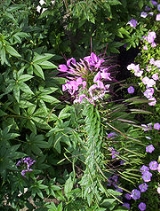
Cleomaceae
Encyclopedia
Cleomaceae is a small family of flowering plant
s in the order Brassicales
, comprising about 300 species in 10 genera. These genera were previously included in the family Capparaceae
, but were raised to a distinct family when DNA
evidence showed that the genera included in it are more closely related to the Brassicaceae
than they are to the Capparaceae. The APG II system
allows for Cleomaceae to be included in the Brassicaceae.
The genera in Cleomaceae include:
Recent DNA studies have failed to separate Cleome, Podandrogyne and Polanisia from each other, so some taxonomists have abandoned the last two of these genera, treating them as part of Cleome sensu lato.
Flowering plant
The flowering plants , also known as Angiospermae or Magnoliophyta, are the most diverse group of land plants. Angiosperms are seed-producing plants like the gymnosperms and can be distinguished from the gymnosperms by a series of synapomorphies...
s in the order Brassicales
Brassicales
The Brassicales are an order of flowering plants, belonging to the eurosids II group of dicotyledons under the APG II system. One character common to many members of the order is the production of glucosinolate compounds...
, comprising about 300 species in 10 genera. These genera were previously included in the family Capparaceae
Capparaceae
Capparaceae , commonly known as the Caper family, is a family of plants in order Brassicales. As currently circumscribed, it contains 33 genera and about 700 species...
, but were raised to a distinct family when DNA
DNA
Deoxyribonucleic acid is a nucleic acid that contains the genetic instructions used in the development and functioning of all known living organisms . The DNA segments that carry this genetic information are called genes, but other DNA sequences have structural purposes, or are involved in...
evidence showed that the genera included in it are more closely related to the Brassicaceae
Brassicaceae
Brassicaceae, a medium sized and economically important family of flowering plants , are informally known as the mustards, mustard flowers, the crucifers or the cabbage family....
than they are to the Capparaceae. The APG II system
APG II system
The APG II system of plant classification is the second, now obsolete, version of a modern, mostly molecular-based, system of plant taxonomy that was published in April 2003 by the Angiosperm Phylogeny Group. It was a revision of the first APG system, published in 1998, and was superseded in 2009...
allows for Cleomaceae to be included in the Brassicaceae.
The genera in Cleomaceae include:
- CleomeCleomeCleome is a genus of flowering plants in the family Cleomaceae. Previously it had been placed in family Capparaceae, until DNA studies found the Cleomaceae genera to be more closely related to Brassicaceae than Capparaceae...
- CleomellaCleomellaCleomella is a small genus of about ten species of flowering plants. Like their relatives, the cleomes, plants of this genus have traditionally been included in the caper family Capparaceae but have recently been moved into a new family, Cleomaceae. Cleomella are annual wildflowers native to the...
- Dactylaena
- Haptocarpum
- OxystylisOxystylisOxystylis is a monotypic genus of flowering plants currently considered a part of the cleome family containing the single species Oxystylis lutea, which is known by the common name spiny caper. It is native to the Mojave Desert straddling the border between California and Nevada. It grows in rocky...
- PodandrogynePodandrogynePodandrogyne is a genus of plant in family Cleomaceae. It contains about 100 species, including:* Podandrogyne brevipedunculata, Cochrane* Podandrogyne jamesonii, Cochrane* Podandrogyne trichopus, H.H.Iltis & Cochrane...
- PolanisiaPolanisiaPolanisia is a genus of flowering plants in the Cleome family, Cleomaceae. Members of the genus are commonly known as clammyweeds. P. jamesii is listed as endangered in Minnesota, while P. dodecandra is found throughout North America....
- WislizeniaWislizeniaWislizenia is a monotypic genus of flowering plant containing the single species Wislizenia refracta, which is known by the common names spectacle fruit and jackass clover. Like genus Cleome and several relatives, Wislizenia has traditionally been included in the caper family, Capparaceae, but has...
Recent DNA studies have failed to separate Cleome, Podandrogyne and Polanisia from each other, so some taxonomists have abandoned the last two of these genera, treating them as part of Cleome sensu lato.

